.jpg?width=813&name=Webp.net-compress-image%20(1).jpg)
It goes without saying that food packaging ultimately provides a way to keep food safe, clean as well as shelf-stable. Nonetheless, the majority of food packaging is essentially designed to be used once and then thrown away; most of it is not recyclable. For the most part, food packaging is thrown away and can often be seen littering our highways, byways and waterways.
So much food packaging, plastic especially, has finished up in our waterways and as such, a planetary crisis has been declared by the United Nations due to the excessive amount of plastic pollution in our oceans and waterways. This is not only a major problem for humanity, but also for aquatic life.
Whilst it may be more difficult to find food that is unpackaged completely, you can choose packaging that is more sustainable and ecologically sound which causes less damage to animals, people and the environment.
Practically all the food that we buy, especially canned and packet (processed) food comes in a package or packet. Supermarkets, markets, fast food or online delivery food all comes packaged and it is difficult to find food that doesn’t come in some sort of packaging.
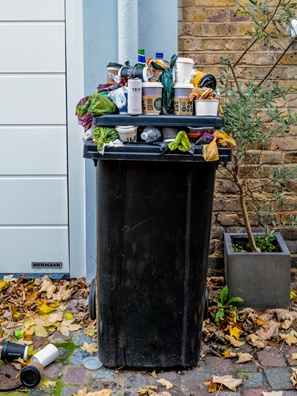
Packaging used predominantly for food has certainly come on leaps and bounds in recent years and a variety of synthetic and manufactured materials, including glass, ceramics, metal, cardboard, paper, wax, wood and of course plastic is used.
Most of the packaging used for food is constructed from paper cardboard, glass and of course our old favourite and the most difficult to recycle; plastic.
Plastics that are used for packaging have, in some regards, come a long way since they started being used as the norm and some of the more modern plastics are made from plant matter such as corn although the majority of plastic packaging is still made from petroleum and includes polymers as an additive.
There are lots of variants when it comes to packaging and different types of packaging can contain coatings of a different material (usually plastic) and the majority of packaging comes labelled using printing inks; another example is paperboards which frequently have a lining of plastic that isn’t visible to the naked eye.
It seems that the main culprits for excessive packaging which ultimately leads to excessive waste are takeaway food and processed food.
Let’s take fast food for example; burgers wrapped in paper or plastic, then put into styrofoam or cardboard boxes, then put into a paper bag and then, more often than not, placed into a plastic bag which usually contain plastic knives and forks, napkins and also straws.
Again, processed food has layers of packaging; for example, a lasagne comes in a metal or cardboard type tray, then covered with a plastic film, then put into a cardboard box and more often than not will be wrapped again in some sort of plastic film or wrap.
Current practices in food production as well as consumption does unfortunately generate a colossal amount of packaging. Nonetheless, new, more sustainable and eco-friendly types of packaging are being developed on a continual basis. The food industry has the highest demand for packaging with around two thirds of all packaging material that is produced being used to package foodstuffs.
Most packaging has been designed and manufactured to be used just once and is unfortunately thrown in the trash instead of being repurposed or recycled.
Whilst recycling does help to minimise the actual amount of waste packaging that makes its way to a landfill site, in reality some simple, basic choices we can all make when purchasing our food can eliminate the need for so much packaging in the first place.
Sending food and drinks in the post can pose double the danger – you want the products to remain fresh, and in some cases even cool, and you want to keep them safe from damage, squashing or smashing. Different food and drinks products have different problems to address, but here are some of the latest packaging solutions which are improving the way we post consumables.
Packaging for glass and bottles
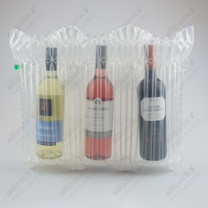 Inflatech™ air pocket
Inflatech™ air pocket
For the discerning wine drinker, bulk-buying bottles is one easy way to build up the wine collection. This packaging solution from Inflatech™ provides inflated packaging for three bottles, removing the risk of breakage during the transport process.

UPS approved spirits packaging
An innovative new solution – this unique packaging solution includes plastic wrapping to secure the glass bottle in place, and cardboard flaps to provide a further layer of protection from damage during transport.
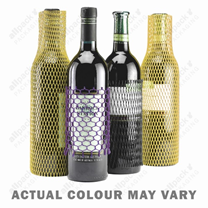
Mesh sleeving
This classic solution from Allpack is versatile and reliable. The soft and flexible mesh can be stretched over bottles, glasses or crockery and provides an added layer of protection against chips, cracks and breaks. When used alongside packing paper, bubble wrap or void fill solutions inside a packing box, the mesh sleeving provides an extra layer of protection, for reassurance.
Void fill for glass and bottles

Airpillow Systems Airbubble
The Airpillow bubble system is a lightweight void fill solution offering damage limitation by filling the extra space in a packaging box to stop the products from moving. This is particularly useful for glass bottles and other breakable objects. These plastic bubbles weigh very little and are easily recycled.

Paper Shooter Voidfill System Paperplus
This paper void fill solution is a heavier packing solution but affords significantly more flexibility than the air bubbles. The crumpled paper is manipulated into chevrons, giving the paper more strength to provide insulation and protective layering between glass and other food and drinks products. This is a more environmentally friendly solution than the plastic void fill, however this solution can add more weight to the package.
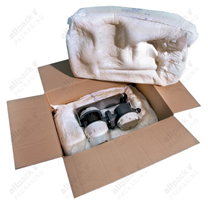
Instapak® Foam Instapack Quick bag
This polyurethane foam can be moulded to the product during production to create a bespoke void fill solution that prevents movement in the box and protects the product from damage. Polyurethane is considered more eco-friendly than most plastics, making it a good solution for glass packaging.
Packaging for fresh food
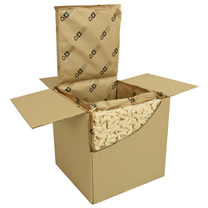
Enviro friendly insulated box liners
This solution includes a box and an insulated liner to keep products fresh and cool. The insulation is made of starch and paper so it is fully biodegradable, and it outperforms polystyrene equivalents over 48 hours. This packaging maintains a consistent temperature for the products within over 48 hours.

Woolcool fleece liners
This innovative product uses the natural insulating properties of wool to insulate fresh food packages of up to 30kg. These liners are usually used for fresh fruit and vegetables, chocolates and confectionaries and are fully compostable.